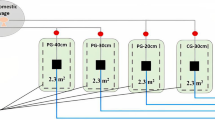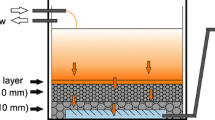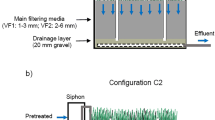Abstract
Constructed vertical macrophyte systems, for nitrogen removal from oil refinery wastewater, were investigated. Detailed studies were carried out in laboratory columns (diameter, 0.06 m; depth, 0.5 m; operating volume, 0.6 L) planted with common reed, Phragmites australis. Through a vertical flow format, collected oil refinery wastewater was supplied directly to the columns. Wastewater quality varied through the experimental period with initial ammonia concentrations ranging from 3 to 20 mg N L-1. Effective ammonia removal was obtained for the planted columns with a hydraulic detention time of 5 hr. Removal efficiencies above 90% was obtained for high (above 6 mg N L-1) ammonia inflow concentrations. A satisfactory ammonia removal was obtained at shorter detention times for the low initial concentrations. Longer detention times also provided organic nitrogen removal. Recirculation of the flow, which provides the same total detention time but a higher hydraulic loading, provides the possibility to adjust the flow rate and the inflow ammonia concentration with detention time to achieve a target outflow concentration.
Similar content being viewed by others
References
American Petroleum Institute (API): 1998, The Use of Treatment Wetlands for Petroleum Industry Effluents, Health and Environmental Sciences Department, Publication number 4672, Washington, D.C., 140 pp.
Breen, P. F. and Chick, A. J.: 1989, ‘Wastewater treatment using artificial wetlands: The hydrology and treatment performance of horizontal and vertical flow system’, Australian Water and Wastewater Association 13th Federal Convention, Canberra, March 1989, pp. 167–171.
Breen, P. F.: 1990, ‘A mass balance method for assessing the potential of artificial wetlands for wastewater treatment’, Wat. Res. 24(6), 689–697.
Breen, P. F. and Chick A. J.: 1995, ‘Rootzone dynamics in constructed wetlands receiving wastewater: A comparison of vertical and horizontal flow systems’, Wat. Sci. Tech. 32, 281–290.
Cooper, P. Smith, M. and Maynard, H.: 1997, ‘The design and performance of a nitrifying vertical-flow reed bed treatment system’, Wat. Sci. Tech. 35, 215–221.
Farahbakhshazad, N., Morrison, G. M., Larsson, Å. and Weisner S. E. B.: 1995, ‘Effect of Grain Size on Nutrient Removal from Wastewater in Small Scale Planted Macrophyte Systems’, in R. Ramadori, L. Cingolani and L. Cameroni (eds), Natural and Constructed Wetlands for Wastewater Treatment and Reuse-Experiences, Goals and Limits, Perugia, pp. 143–150.
Farahbakhshazad, N. and Morrison G. M.: 1997, ‘Ammonia removal processes for urine in an upflow macrophyte system’, Env. Sci. Tech. 31(11), 3314–3317.
Farahbakhshazad, N. and Morrison G. M.: 1998, ‘Subsurface macrophyte systems in wastewater treatment’, Vatten 54, 41–51.
Farahbakhshazad, N. and Morrison, G. M.: 2000, ‘A Constructed Vertical Macrophyte System for Retention of Nitrogen in Agricultural Runoff’, Env. Tech. 21(2), 217–223.
Hammer, D. A. and Knight, R. L.: 1994, ‘Designing constructed wetlands for nitrogen removal’, Wat. Sci Tech. 29(4), 15–27.
Knight, R. L., Kadlec, R. H. and Ohlendorf, H. M.: 1999, ‘The use of treatment wetlands for petroleum industry effluents’, Env. Sci. Tech. 33(7), 973–980.
Laber, J., Perfler, R. and Haberl, R.: 1997, ‘Two strategies for advanced nitrogen elimination in vertical flow constructed wetlands’, Wat. Sci. Tech. 35(5), 71–77.
Litchfield, D. K.: 1990, ‘Constructed Wetlands for Wastewater Treatment at Amoco Oil Company's Mandan, North Dakota, refinery’, in P. F. Cooper and B. C. Findlater (eds), Constructed Wetlands in Water Pollution Control, Pergamon Press, Oxford, pp. 399–402.
Mitchell, D. S. Breen, P. F. and Chick, A. J.: 1990, ‘Artificial Wetlands for Treating Wastewater from Single Households and Small Communities’, in P. F. Cooper and B. C. Findlater (eds), Constructed Wetlands in Water Pollution Control, Pergamon Press, Oxford, pp. 383–389.
Morris, M. and Herbert, R.: 1997, ‘The design and performance of a vertical flow reed bed for the treatment of high ammonia/low suspended solid organic effluents’, Wat. Sci. Tech. 35, 197–204.
Reddy, K. R. and D'Angelo, E. M.: 1997, ‘Biogeochemical indicators to evaluate pollutant removal efficiency in constructed wetlands’, Wat. Sci. Tech. 35, 1–10.
Rogers, K. H., Breen, P. F. and Chick, A. J.: 1991,'Nitrogen removal in experimental wetland treatment systems: Evidence for the role of aquatic plants’, J. Wat. Pollut. Cont. Fed. 63(7), 934–941.
Schierup, H.-H., Brix, H. and Lorenzen, B.: 1990, ‘Wastewater Treatment in Constructed Reed Beds in Denmark – State of the Art’, in P. F. Cooper and B. C. Findlater (eds), Constructed Wetlands in Water Pollution Control, Pergamon Press, pp. 495–504.
Simi, A. L. and Mitchell, C. A.: 1999, ‘Design and hydraulic performance of a constructed wetland treating oil refinery wastewater’, Wat. Sci. Tech. 40(3), 301–308.
Sun, G., Gray, K. R. and Biddlestone, A. J.: 1998, ‘Treatment of agricultural and domestic effluents in constructed downflow reed beds employing recirculation’, Env. Tech. 19, 529–536.
Tanner, C. C.: 1994, ‘Treatment of diary farm wastewaters in horizontal and up-flow gravel-bed constructed wetlands’, Wat. Sci. Tech. 29(4), 85–93.
Tanner, C. C., Clayton, J. S. and Upsdell, M. P.: 1995, ‘Effect of loading rate and planting on treatment of dairy farm wastewaters in constructed wetlands – II. Removal of nitrogen and phosphorus’, Wat. Res. 29(1), 27–34.
Tchobanoglous, G.: 1991, ‘Land-Based Systems, Constructed Wetlands, and Aquatic Plant Systems in the United States: An Overview’, in C. Etnier and B. Guterstam (eds), Ecological Engineering for Wastewater Treatment. Proceedings of the International Conference, March 1991, Stensund Folk College, Sweden, pp. 110–124.
Von Felde, K. and Kunst, S.: 1997, ‘N and COD removal in vertical flow systems’, Wat. Sci. Tech. 35, 79–85.
White, K. D.: 1995, ‘Enhancement of nitrogen removal in subsurface flow constructed wetlands employing a 2-stage configuration, and unsaturated zone and recirculation’, Wat. Sci. Tech. 32, 59–67.
Zhu, T. and Sikora F. J.: 1995, ‘Ammonia and nitrate removal in vegetated and unvegetated gravel bed microcosm wetlands’, Wat. Sci. Tech. 32(3), 219–228.
Author information
Authors and Affiliations
Corresponding author
Rights and permissions
About this article
Cite this article
Moreno, C., Farahbakhshazad, N. & Morrison, G.M. Ammonia Removal from Oil Refinery Effluent in Vertical Upflow Macrophyte Column Systems. Water, Air, & Soil Pollution 135, 237–247 (2002). https://doi.org/10.1023/A:1014753817216
Issue Date:
DOI: https://doi.org/10.1023/A:1014753817216




